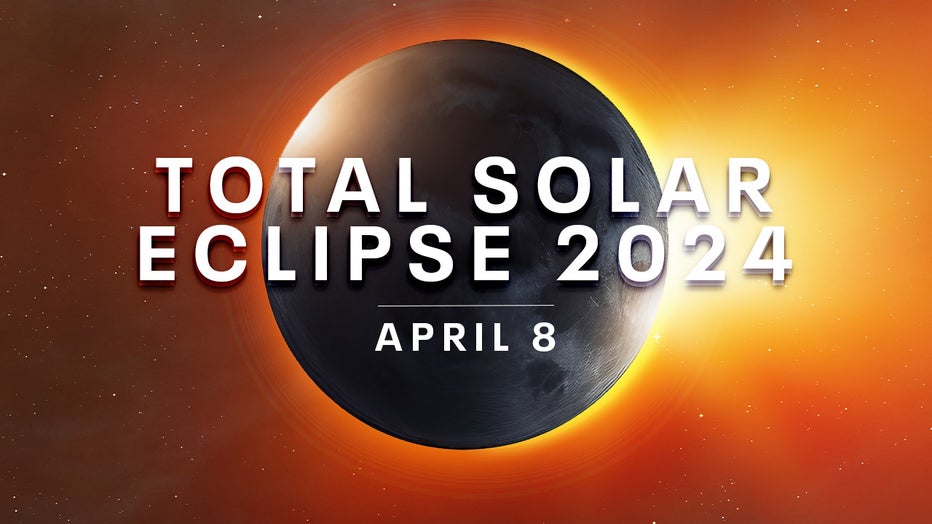Solar eclipse 2024: Southeast Wisconsin peak times, path
MILWAUKEE - Millions of spectators along a narrow corridor stretching from Mexico to the U.S. to Canada eagerly awaited Monday's celestial sensation — a total eclipse of the sun — even as forecasters called for clouds.
The best weather was expected at the tail end of the eclipse in Vermont and Maine, as well as New Brunswick and Newfoundland.
What time is the solar eclipse?
Southern Texas will see the peak of totality first, around 1:30 p.m. Central Daylight Time. Then Dallas at 1:42 p.m., with the time getting later and later as the moon’s shadow moves north. Indianapolis will see the peak around 3:05 p.m. Eastern Daylight Time; Cleveland at 3:15 p.m., and northern Maine around 3:30 p.m.
However, it will take several hours for the moon to move across the sun, so the actual eclipse event will start just over an hour before the peak of totality, with more and more of the sun slowly being blocked.
How long is the solar eclipse?
Again, that depends on where you are. Those closest to the center of the path will see total darkness for about four minutes at the peak of totality.
But because the moon moves slowly across the sun’s path, the entire eclipse event – from when the moon first clips the sun until the time it clears – will last from 90 minutes to over two hours for those in the path of totality.

Total solar eclipse over North America
The best weather was expected at the tail end of the eclipse in Vermont and Maine, as well as New Brunswick and Newfoundland.
The out-of-sync darkness lasts up to 4 minutes, 28 seconds. That's almost twice as long as it was during the U.S. coast-to-coast eclipse seven years ago because the moon is closer to Earth. It will be another 21 years before the U.S. sees another total solar eclipse on this scale.
SIGN UP TODAY: Get daily headlines, breaking news emails from FOX6 News
Extending five hours from the first bite out of the sun to the last, Monday's eclipse begins in the Pacific and makes landfall at Mazatlan, Mexico, before moving into Texas, Oklahoma, Arkansas and 12 other U.S. states in the Midwest, Middle Atlantic and New England, and then Canada. Last stop: Newfoundland, with the eclipse ending in the North Atlantic.
It will take just 1 hour, 40 minutes for the moon's shadow to race more than 4,000 miles (6,500 kilometers) across the continent.
Eye protection is needed with proper eclipse glasses and filters to look at the sun, except when it ducks completely out of sight during an eclipse.
The path of totality — approximately 115 miles (185 kilometers) wide — encompasses several major cities this time, including Dallas, Indianapolis, Cleveland, Buffalo, New York and Montreal. An estimated 44 million people live within the track, with a couple hundred million more within 200 miles (320 kilometers). Add in all the eclipse chasers, amateur astronomers, scientists and just plain curious, and it’s no wonder the hotels and flights are sold out and the roads jammed.
FREE DOWNLOAD: Get breaking news alerts in the FOX6 News app for iOS or Android
Experts from NASA and scores of universities are posted along the route, poised to launch research rockets and weather balloons, and conduct experiments. The International Space Station’s seven astronauts also will be on the lookout, 270 miles (435 kilometers) up.

Local events
Discovery World
Monday, April 8, 2024
10 a.m. – 3 p.m. (maximum coverage at 2:08 p.m. CST)
Join us at Discovery World, your lakefront destination, to witness the solar eclipse. Catch the maximum coverage of 89.4% in Milwaukee, WI around 2:08 p.m. at Discovery World.
Milwaukee Public Museum
800 W. Wells St., Milwaukee, WI 53233
Outside MPM by the Green Clock on Wells Street: 12:30 - 3 p.m.
The Milwaukee Public Museum will have telescopes with special filters to protect your eyes. Eclipse glasses will be available for $2. In the event of inclement weather, the museum will provide educational activities.
UWM Manfred Olson Planetarium
1900 E. Kenwood Blvd. #139, Milwaukee, WI 53211
UWM Union Ballroom (rain or shine) and Spaights Plaza (weather permitting) 1 - 3 p.m.
UWM will provide free food, music and crafts. Telescopes and eclipse viewing glasses will be available.
Wehr Nature Center
9701 W. College Ave., Franklin, WI 53132
12:30 - 3:30 p.m.
Wehr Nature Center will have filtered telescopes. Eclipse glasses will be on sale for $1. The event is free, parking is $5 for non-members.
Horwitz-DeRemer Planetarium at the Retzer Nature Center
S14 W28167, Madison St., Waukesha, WI 53188
9 a.m. - 3 p.m. Eclipse glasses will be provided to the first 100 guests.
Schlitz Audubon Nature Center
1111 E Brown Deer Road, Bayside, WI 53217
On the Veranda 12:30 - 3:30 p.m. Free with membership or admission. Filtered telescopes and eclipse glasses will be provided.
Yerkes Observatory
Solar Eclipse Open House: 1-5 p.m.Reservations are required. Tickets can be purchased here. There will be no parking on-site, but there will be free trolley rides from Williams Bay School.


